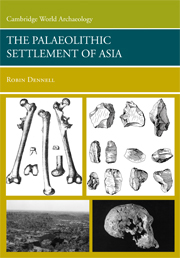Book contents
- Frontmatter
- Contents
- List of Tables, Figures, and Boxes
- Preface
- 1 Asia and Its Place in Palaeoanthropology
- 2 The African Background to the Colonisation of Asia
- 3 The Climatic and Environmental Background to Hominin Settlement in Asia before 1 MA
- 4 The Earliest Inhabitants of Southwest Asia
- 5 The Earliest Inhabitants of South and Southeast Asia and China
- 6 “Out of Africa 1” Reconsidered and the Earliest Colonisation of Asia
- 7 The Climatic and Environmental Background to Hominin Settlement in Asia between ca. 1 Ma and the Last Interglacial
- 8 The Middle Pleistocene Archaeological Record for Southwest and Central Asia
- 9 The Middle Pleistocene Archaeological Record of the Indian Subcontinent
- 10 The Middle Pleistocene Archaeological Record of China and Southeast Asia
- 11 Human Evolution in Asia during the Middle Pleistocene
- 12 Concluding Remarks
- Appendix 1 The Sizes of Countries and Regions in Asia, with Comparative Examples
- Appendix 2 Geographical Coordinates of Principal Early Palaeolithic Sites in Asia
- Appendix 3 Geographical Coordinates of Geological Sections and Cores
- Appendix 4 English Names of Various Mammals Recorded in Asia
- Bibliography
- Index
2 - The African Background to the Colonisation of Asia
Published online by Cambridge University Press: 05 June 2012
- Frontmatter
- Contents
- List of Tables, Figures, and Boxes
- Preface
- 1 Asia and Its Place in Palaeoanthropology
- 2 The African Background to the Colonisation of Asia
- 3 The Climatic and Environmental Background to Hominin Settlement in Asia before 1 MA
- 4 The Earliest Inhabitants of Southwest Asia
- 5 The Earliest Inhabitants of South and Southeast Asia and China
- 6 “Out of Africa 1” Reconsidered and the Earliest Colonisation of Asia
- 7 The Climatic and Environmental Background to Hominin Settlement in Asia between ca. 1 Ma and the Last Interglacial
- 8 The Middle Pleistocene Archaeological Record for Southwest and Central Asia
- 9 The Middle Pleistocene Archaeological Record of the Indian Subcontinent
- 10 The Middle Pleistocene Archaeological Record of China and Southeast Asia
- 11 Human Evolution in Asia during the Middle Pleistocene
- 12 Concluding Remarks
- Appendix 1 The Sizes of Countries and Regions in Asia, with Comparative Examples
- Appendix 2 Geographical Coordinates of Principal Early Palaeolithic Sites in Asia
- Appendix 3 Geographical Coordinates of Geological Sections and Cores
- Appendix 4 English Names of Various Mammals Recorded in Asia
- Bibliography
- Index
Summary
INTRODUCTION
The fundamental assumption that underpins studies of the earliest hominin colonisation of Asia is that it was accomplished by Homo erectus, but no other types of hominin. To outline briefly the “big picture” of early Asian prehistory: our own genus and the ability to make stone tools and butcher large animals are thought to have originated in East Africa shortly after 2.6 Ma at a time when grasslands were expanding under a cooler and drier climate. Homo erectus is thought to have emerged in East Africa ca. 1.9 Ma, and then shortly afterwards expanded its distribution into Southwest Asia ca. 1.8 Ma (Chapter 4) and reached Java and North China (on current estimates; see Chapter 5) by ca. 1.6 Ma. When viewed close up, however, the actual process of expansion is probably a great deal more complicated than this simple scenario, and alternative scenarios can be suggested (see Chapters 4 and 6). In this chapter, we examine the African fossil hominins and archaeological and climatic record that preceded the earliest evidence for hominins in Asia.
The fossil hominin record for Africa before ca. 1.0 Ma is a story of two types of hominin. (Box 2.1 discusses the meaning of the term “hominin”.) The first types were australopithecines, or australopiths: this “australopithecine world” was in place by ca. 4 Ma, and lasted until they finally became extinct ca. 1.2–1.4 Ma. The second type was our own genus Homo, which first appeared (on current evidence) shortly after 2.4 Ma.
- Type
- Chapter
- Information
- The Palaeolithic Settlement of Asia , pp. 9 - 34Publisher: Cambridge University PressPrint publication year: 2008



